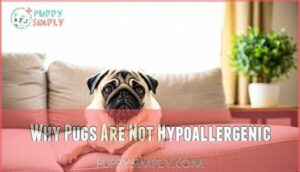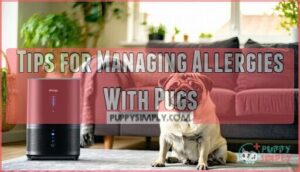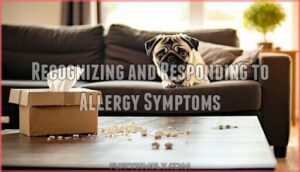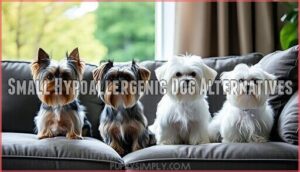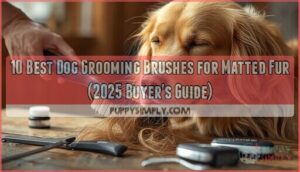This site is supported by our readers. We may earn a commission, at no cost to you, if you purchase through links.
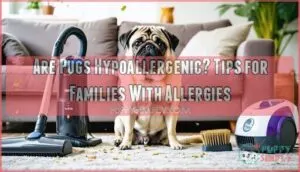
But that doesn’t mean families with allergies can’t live comfortably alongside these wrinkly companions. With the right strategies for grooming, cleaning, and allergen management, you can markedly reduce reactions and make sharing your space with a pug more manageable.
Table Of Contents
- Key Takeaways
- Are Pugs Hypoallergenic Dogs?
- What Causes Allergies to Pugs?
- Why Pugs Are Not Hypoallergenic
- Tips for Managing Allergies With Pugs
- Recognizing and Responding to Allergy Symptoms
- Allergy-Friendly Dog Breeds for Families
- Frequently Asked Questions (FAQs)
- Can you develop allergies to dogs later in life?
- Do pug puppies shed less than adult pugs?
- What are the most budget-friendly ways to manage allergies with a pug?
- How often should you bathe a pug if you have allergies?
- What fabrics attract the least amount of pet dander?
- Can pugs trigger asthma attacks in children?
- Do pug puppies cause fewer allergic reactions?
- How long do pug allergens stay airborne?
- Can allergy shots help with pug allergies?
- Are male or female pugs less allergenic?
- Conclusion
Key Takeaways
- Pugs are not hypoallergenic because they shed year-round and produce dander, saliva, and urine proteins (like Can f 1) that trigger allergic reactions in about 64% of dog allergy sufferers.
- Daily outdoor brushing, weekly baths with hypoallergenic shampoo, and meticulous wrinkle cleaning can significantly reduce allergen levels in your home without requiring expensive products.
- HEPA-filtered vacuums and continuous air purifiers combined with pet-free bedroom zones create a practical defense system that cuts allergen exposure dramatically for families determined to keep their pugs.
- If pug allergies prove unmanageable, compact hypoallergenic alternatives like Bichon Frises, Miniature Poodles, and American Hairless Terriers offer similar charm with minimal shedding and dander production.
Are Pugs Hypoallergenic Dogs?
If you’re hoping a pug might work for your allergies, let’s get straight to what "hypoallergenic" actually means. The truth is, no dog breed is completely allergy-free, though some trigger fewer symptoms than others.
Understanding how pug coats interact with allergens will help you make the right choice for your family.
What “Hypoallergenic” Really Means
The word "hypoallergenic" gets thrown around a lot when people are shopping for dogs, but it doesn’t mean what most folks think it does. When we talk about hypoallergenic dog breeds, we’re really referring to dogs that produce fewer allergens—not zero.
It’s about breed classification based on dander and shedding patterns. No dog is completely free of the proteins that trigger allergies, but some breeds are gentler on sensitive systems than others.
Why No Dog is Truly Hypoallergenic
Here’s the truth: dog allergies aren’t about shedding alone—they’re about proteins your body reacts to. Studies show allergen science reveals that even so-called hypoallergenic breeds produce Can f 1 and other allergens at similar levels to other dogs. The hypoallergenic myth persists, but research confirms:
Dog allergies stem from proteins, not just shedding, and even hypoallergenic breeds produce similar allergen levels to other dogs
- Breed variability within the same type exceeds differences between breeds
- Canine dander, saliva, and urine all carry pet allergy triggers
- No breed guarantees you won’t react
Your sensitivity matters more than any breed label. Understanding hypoallergenic breeds is essential for making informed decisions about dog ownership.
How Pug Coats Affect Allergies
Pugs pack double trouble for allergy sufferers—their smooth, short coats shed year-round, sending dander flying into every corner of your home. Unlike poodles or other hypoallergenic breeds with minimal shedding patterns, the pug breed releases a steady stream of dog dander that clings to furniture and fabrics.
Allergen reduction becomes nearly impossible without aggressive coat maintenance and dander control strategies, making pug allergy symptoms common even with regular brushing.
What Causes Allergies to Pugs?
If you’ve ever noticed yourself sneezing around your pug, you’re not imagining things. The culprit isn’t just the fur—it’s a mix of proteins hiding in places you mightn’t expect.
Let’s look at what’s really triggering those allergy symptoms and how your pug spreads these allergens around your home.
Proteins in Dander, Saliva, and Urine
When you’re allergic to dogs, it’s not the fur itself that’s the problem—it’s the proteins hiding in dander, saliva, and urine. Dog saliva actually contains more diverse allergens than dander, with at least twelve different IgE-binding proteins that can trigger allergy symptoms.
Can f 1, the dominant dog allergen found in saliva, affects about 64% of people with dog allergies. These proteins stick to your pug’s skin flakes, get into their drool, and even show up in urine, turning your home into an allergen hotspot.
Understanding allergen components is essential for managing dog allergies effectively.
How Shedding Spreads Allergens
Every time your pug shakes, scratches, or settles into a cozy spot, a cloud of invisible allergens takes flight and spreads throughout your home. Shedding patterns mean pet dander constantly circulates through the air, landing on furniture, carpets, and even your clothes.
These allergy triggers don’t stay put—they cling to surfaces and float around for hours, making allergen spread impossible to avoid. That’s why dog allergies persist even in rooms your pug rarely enters.
Typical Allergy Symptoms From Pugs
When allergens settle into your system, your body doesn’t stay quiet for long. You’ll likely notice sneezing, nasal congestion, or itchy, watery eyes within minutes of contact. Skin irritation—like rashes or hives—can appear where your pug’s dander touched you.
Respiratory issues, including coughing or wheezing, signal your airways reacting to these allergy triggers. These allergic reactions vary in intensity, but they’re your body’s way of fighting what it sees as invaders.
Why Pugs Are Not Hypoallergenic
If you’ve fallen for a pug’s charm but worry about allergies, it’s important to understand why these lovable dogs won’t work for everyone. Pugs produce allergens at levels that can trigger reactions in sensitive people, and it comes down to how their bodies and coats work.
Let’s look at three specific reasons pugs aren’t a good match for allergy sufferers.
Pug Shedding Patterns
If you’ve ever watched a pug walk across your hardwood floor, you’ve probably noticed the trail of fur they leave behind—almost like a tiny, adorable snowstorm. Pugs shed consistently throughout the year, which means allergen exposure doesn’t take a break.
Their shedding patterns include:
- Year-round hair loss with no real "off season"
- Heavier shedding seasons in spring and fall
- Short, smooth coat texture that releases fine hairs easily
- Constant dander production that clings to shed fur
This combination makes hypoallergenic claims about pugs unrealistic for allergy sufferers.
Dander Production and Distribution
Dander from pugs isn’t just a surface problem—it becomes airborne and spreads throughout your home. These microscopic skin flakes, usually smaller than 5 micrometers, float in the air for hours and settle into carpets, furniture, and bedding.
Your pug’s wrinkles trap extra dander, creating concentrated allergen hotspots. Environmental factors like poor ventilation make airborne particles linger longer, turning everyday spaces into allergy triggers even after you’ve cleaned.
Grooming Needs and Allergen Accumulation
Skipping regular grooming doesn’t just make your pug look scruffy—it turns them into a walking allergen factory. Without consistent coat maintenance and skin care, loose fur and dander build up quickly. Shedding control becomes nearly impossible, and those wrinkles? They trap allergens like a lint roller in reverse.
Here’s what happens without proper dog grooming:
- Dead skin cells accumulate faster than your vacuum can manage
- Wrinkle cleaning delays let moisture and proteins create allergy hotspots
- Loose hair spreads dander throughout your home daily
- Saliva from self-grooming adds another allergen layer to their coat
Tips for Managing Allergies With Pugs
If you love pugs but struggle with allergies, you don’t have to give up on having one in your home. There are practical steps you can take to reduce allergen exposure and make living with your pug more comfortable.
Let’s look at some strategies that can help you manage symptoms while enjoying your furry companion.
Grooming and Bathing Routines
Regular grooming isn’t just about keeping your pug looking cute—it’s one of your best tools for cutting down allergens floating around your home. Brush your pug daily outdoors to catch loose fur and dander before they spread inside.
Weekly baths with hypoallergenic shampoo help wash away proteins that trigger reactions, keeping shedding under control and your skin health in check.
Cleaning Wrinkles and Facial Folds
Those adorable face wrinkles that give your pug so much character can also trap dander, saliva, and oils—turning them into allergen hot spots if you’re not careful. Daily fold cleaning keeps allergen buildup in check and protects your pug’s skin health.
Here’s what you need for effective wrinkle care:
- Use soft, damp cloths or unscented baby wipes for gentle cleaning
- Dry each fold thoroughly to prevent moisture-related infections
- Check for redness, odor, or irritation during your daily grooming routine
- Apply vet-approved powder if folds stay damp between cleanings
- Make it part of your morning ritual so you don’t skip days
This simple habit dramatically cuts the allergens hiding in those charming creases.
Vacuuming and Air Purification Strategies
Even with spotless surfaces, dander still floats through your home and settles on every surface—which is where strategic vacuuming and air purification make all the difference. HEPA-filtered vacuum cleaners trap microscopic allergens instead of blowing them back into the air, while air purifiers work continuously to capture floating dander.
Consistent use of these tools dramatically improves allergen reduction throughout your living space.
| Tool | How Often | Key Feature |
|---|---|---|
| HEPA vacuum | Daily high-traffic areas | Captures 99.97% of particles |
| Air purifier | Run 24/7 | Continuous dander removal |
| Upholstery attachment | Weekly furniture cleaning | Reaches fabric fibers |
| Filter replacement | Every 3–6 months | Maintains peak performance |
Training and Household Boundaries
Your vacuum and air purifier do the heavy lifting with floating allergens, but where your pug spends time matters just as much as how often you clean.
Training pugs to respect pet-free zones—like bedrooms—drastically cuts nighttime exposure to dog dander. Boundary setting through consistent household rules protects allergy sufferers while supporting pug socialization.
Keep furniture off-limits, establish clear room boundaries, and your allergy management strategy becomes twice as effective without sacrificing your dog’s happiness.
Recognizing and Responding to Allergy Symptoms
Knowing what to watch for can make all the difference when you’re living with a pug and dealing with allergies. Some reactions are mild and manageable, while others need immediate attention.
Let’s look at the signs your body might be telling you something, from everyday sniffles to more serious responses that shouldn’t be ignored.
Common Signs of Dog Allergies
If you’ve ever felt your eyes start to water or your nose tickle the moment a pug waddles into the room, you’re not imagining things—your body is reacting to proteins that these lovable dogs naturally produce. Here’s what those reactions usually look like:
- Sneezing and runny nose — pet dander irritates your nasal passages, triggering that familiar stuffiness
- Eye irritation — itchy, watery eyes are your body’s way of flushing out allergens it sees as threats
- Skin reactions — rashes or hives can pop up where dander touches your skin
- Respiratory issues — coughing or wheezing happens when airborne allergens reach your lungs
Severe Reactions and When to Seek Help
While most pug allergies feel like a nuisance, some reactions cross the line into dangerous territory—and knowing that difference could literally save your life. Anaphylaxis signs demand immediate emergency medical response—think swelling airways, labored breathing, or feeling like you can’t catch your breath.
| Anaphylaxis Signs | Emergency Response |
|---|---|
| Difficulty breathing, wheezing | Call 911 immediately |
| Swelling in throat/airways | Use EpiPen if prescribed |
| Severe shortness of breath | Don’t wait—act fast |
| Respiratory failure symptoms | Seek medical intervention now |
These allergic reactions to allergy triggers aren’t something you push through. Immunological disorders can escalate quickly, so trust your instincts and get help.
Long-Term Health Risks and Prevention
Living with untreated allergies isn’t just uncomfortable—it sets the stage for serious chronic care challenges down the road. Up to 38% of kids with pet allergies develop asthma, making prevention strategies vital.
Consistent allergy management, including immunotherapy and daily medication, reduces your risk of respiratory distress. Don’t skip doses or ignore symptoms; missed treatments increase allergic reactions and complications.
Hypoallergenic alternatives or environmental controls can prevent anaphylaxis risks long-term.
Allergy-Friendly Dog Breeds for Families
If you love pugs but can’t tolerate the sneezing, you’re not alone—plenty of families face this exact dilemma. The good news is there are dog breeds that offer similar charm with far less dander.
Let’s look at some allergy-friendly alternatives that might be the perfect fit for your home.
Breeds Similar to Pugs With Fewer Allergens
When comparing hypoallergenic breeds to pugs, think about temperament and size alongside allergen levels. Several breeds match pugs’ compact stature while producing far less dander:
- Bichon Frise – Weighs 12–18 pounds with a curly coat that traps dander instead of releasing it into your home
- Miniature Poodle – Stands 10–15 inches tall with tightly curled hair that sheds minimally, reducing airborne allergens markedly
- Shih Tzu – Similar dimensions to pugs (9–11 inches) with hair-like fur requiring regular brushing to control dander
- American Hairless Terrier – Eliminates shedding entirely in hairless varieties, making it ideal for severe allergy sufferers
These low shedding breeds offer playful personalities without triggering pet allergies as readily as pugs.
Small Hypoallergenic Dog Alternatives
Allergy sufferers who crave a small companion don’t have to settle for sneezing and watery eyes—several petite breeds deliver pug-level charm without the dander overload.
Affenpinscher care involves minimal shedding despite their wiry coats, while Maltese grooming keeps allergens contained in their silky hair. Chinese crested dogs—especially hairless breeds—eliminate most allergen concerns entirely.
Bichon health benefits include hypoallergenic coats that trap dander rather than spreading it. These nonshedding coats make them truly allergy-friendly dogs for sensitive households.
Choosing The Right Pet for Allergy Sufferers
Finding the perfect match between your family’s needs and a dog’s allergen profile takes more than just crossing your fingers and hoping for the best. Start with allergy testing before bringing any dog home—even hypoallergenic dogs can trigger reactions in sensitive individuals.
Spend time with your chosen breed first, and research health considerations specific to each option. Smart pet selection means balancing your love for pugs with practical family planning that keeps everyone breathing easy.
Frequently Asked Questions (FAQs)
Can you develop allergies to dogs later in life?
Yes, you can absolutely develop dog allergies later in life—even if you’ve been around dogs your whole life without a hitch.
Adult onset allergies happen when your immune system suddenly starts treating pet proteins as threats, triggering allergy symptoms you never experienced before.
Do pug puppies shed less than adult pugs?
Actually, puppies shed less initially, but shedding increases as their adult coat develops. By around 8–12 months, Pugs shed consistently year-round, producing dander that triggers dog allergies regardless of age.
What are the most budget-friendly ways to manage allergies with a pug?
Think of managing pet allergies like tending a garden on a shoestring—you don’t need fancy tools, just consistency.
Budget grooming through regular brushing outdoors, affordable vacuums with HEPA filters, and weekly home cleaning dramatically reduce dog allergies without breaking the bank.
How often should you bathe a pug if you have allergies?
For allergy prevention, bathe your pug weekly with hypoallergenic shampoos. This bathing frequency helps with shedding control and reduces dog allergens in dander.
Regular pug grooming and dog grooming for allergies keeps proteins from spreading around your home.
What fabrics attract the least amount of pet dander?
Don’t assume smooth equals safe—even sleek fabrics can trap allergens.
Tightly woven microfiber fabrics, leather upholstery, and synthetic materials like vinyl repel pet dander better than cotton blends or bamboo textiles, which trap dog dander and pet hair.
Can pugs trigger asthma attacks in children?
Unfortunately, pugs can trigger asthma symptoms in children who are allergy sufferers. Their dander and saliva contain proteins that worsen airway sensitivity, potentially causing breathing difficulties and other respiratory issues in vulnerable kids.
Do pug puppies cause fewer allergic reactions?
Pug puppies produce the same allergens as adult dogs. Breed-specific reactions don’t change with age, since pet dander reduction depends on proteins in saliva and skin, not maturity.
Infant exposure and puppy allergy tests help determine compatibility before adoption.
How long do pug allergens stay airborne?
Imagine microscopic particles drifting like dust in sunlight—that’s pug dander floating through your home. Airborne allergen particles can linger for hours, sometimes days, without proper air purification.
Pet allergy management requires understanding this allergen lifespan to control dog allergies and minimize hypoallergenic concerns around pugs.
Can allergy shots help with pug allergies?
Immunotherapy—commonly known as allergy shots—can gradually reduce your sensitivity to dog allergens, including those from pugs. Shot effectiveness rates vary, but many patients see meaningful improvement after several months of treatment, making it a solid pug allergy treatment option worth discussing with your allergist.
Are male or female pugs less allergenic?
There’s no scientific evidence that pug gender differences affect allergen variation. Both male and female pugs produce similar proteins in their dander, saliva, and urine that trigger dog allergies and allergy symptoms, regardless of sex hormones or slight coat thickness variations.
Conclusion
Studies show that roughly 10% of the U.S. population has pet allergies, yet many still share homes with dogs they adore. Living with pugs when you have allergies isn’t impossible—it just requires commitment.
Regular grooming, strategic cleaning, and smart household boundaries can transform your experience. These are pugs hypoallergenic tips for families with allergies that genuinely work. You’re not choosing between your health and a beloved companion; you’re learning to manage both with care and consistency.


